HOW CAN WE HELP?
Did you know that a quarter of all our bones are found in our feet?
Each foot contains 26 bones, 33 joints and a network of over 100 muscles, tendons and ligaments.
Our feet have about 250,000 sweat glands which produce up to half a pint of perspiration each day. There are approximately 8,000 nerves in the feet—that's more per square cm than any place else on our body.
Maintaining our foot health is important for all of us. Feet are our body's foundation, so keeping them healthy is vital. Years of wear and tear can be hard on our feet with guestimates suggesting that the average adult walks at least 75,000 miles in their lifetime!
Overuse, shoes that don't fit properly and even genetics can lead to injuries and disorders of the foot which can really affect our mobility and wellbeing.
We help people of all ages and abilities to look after their feet and successfully treat a wide range of conditions
We help patients with a wide range of problems including;
Corns
A corn is a painful area of thickened skin which often develops where there has been increased pressure. It is different to callus in that the area of hard skin is more concentrated and forms deeper into the skin, which makes it more painful.
Corns can be anywhere on the foot, but often are located on the sole or on/ or between the toes, or even on the tops of toes. They are best described as a small area of thickened skin which may be tender to touch.
What causes a corn?
A corn can develop when an area is put under too much pressure, and the body produces an area of thickened skin to protect the area. As this thickened skin continues to accumulate, the area often becomes painful. Common causes of corns include;
- wearing high heels, ill-fitting shoes or shoes that are the wrong size
- not wearing socks with shoes
- Foot and biomechanical abnormalities
- Excessive activity such as running or walking
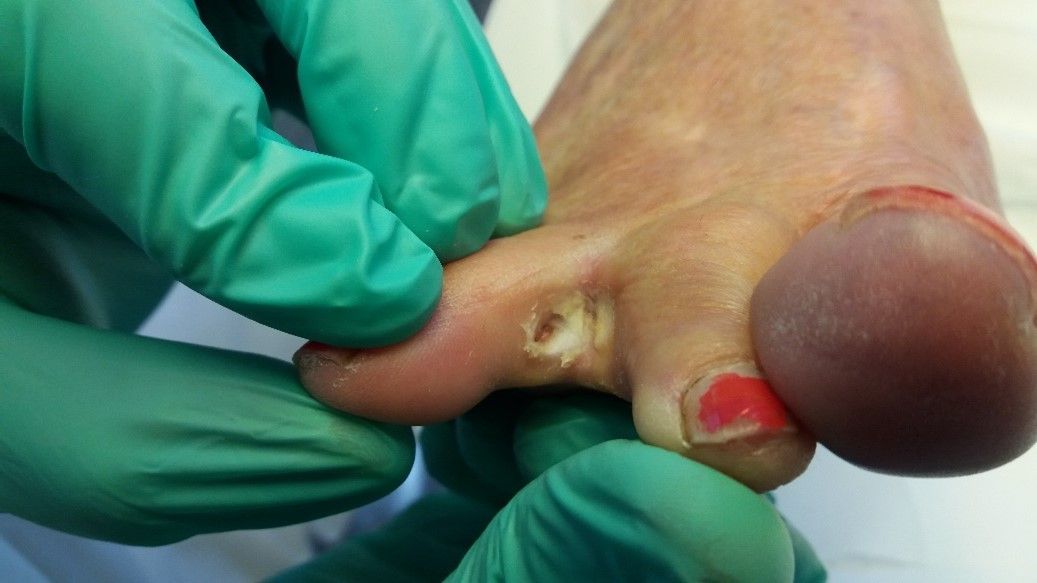
How can we help?
If you have diabetes, heart disease or problems with your circulation, do not try to treat corns yourself, as these conditions can make foot problems more serious.
Treatment of a corn begins with an assessment to determine the underlying cause. This allows us to decide the most suitable treatment plan for you. The overlying hard skin is removed, and the corn is then enucleated (cut out) by using a scalpel. For most people this procedure is painless, but some severe corns may be uncomfortable to remove, in both cases it is not uncommon for there to be some bleeding.
As corns are usually caused by foot structure and footwear, there is a risk of recurrence and how quickly the corn may return depends on a variety of factors, which we will discuss. Including what action you can take to reduce the risk;
- Footwear advice
- Using different padding techniques to reduce pressure
- Attending podiatry appointments to prevent the corn building up to a painful level
Callus
Calluses are larger patches of rough, thick skin, most often found on the sole and heel of the foot or the sides and surface of the toes. If left untreated, they can cause discomfort. Callus build up can be particularly dangerous in patients with poor circulation or diabetic neuropathy, as the combination of excessive pressures and lack of sensation can lead to the formation of ulcers, which if left untreated can cause infection.
What causes callus?
Callus is usually caused by an underlying problem such as a bony deformity, a particular style of walking or more often inappropriate or poorly fitting footwear. Some people have a natural tendency to form callus because of their skin type. Older people have less fatty tissue in their skin and this can lead to callus forming on the ball of the foot.

How can we help?
Callus treatment involves the removal of the thickened areas of skin using a scalpel blade
The aim of callus treatment is to remove the excessive pressure that is causing its build-up, reduce any discomfort and improve both the appearance and function of the skin.
As part of the treatment, we will assess and determine the cause of the callus and as such offer advice regarding
- Footwear
- Padding techniques to reduce or redistribute pressures. Older people can benefit from padding to the ball of the foot, to compensate for any loss of natural padding.
- Emollient creams that can help delay callus building up and help improve the skin’s natural elasticity.
- Orthotic intervention to relieve any excessive pressures
- Attending podiatry appointments to prevent the callus building up to a painful level
Cracked heels
Cracked heels can develop when the area of skin around the heel becomes excessively dry and begins to crack or when the area is too soft and wet, making it more susceptible to splitting. When the condition of the skin around the heel is abnormally dry or wet and the area is put under pressure from the weight of the body, the skin cannot stretch and spread to accommodate the increased pressure as it normally would and so it begins to split.
Cracked heels can be an issue for patients as they are often painful and unsightly, however split heels can be a more serious issue as provide a means for infection.
What are the causes of cracked heels?
The following are some of the more common causes of cracked heels;
- Wearing inappropriate footwear such as open back shoes
- Standing for long periods
- Autonomic neuropathy
- Certain medical conditions such as diabetes
- Being overweight
How can we help?
Typically, we help our patients by undertaking a combination of the following;
- Debriding (removing) the hard skin around the heels with a scalpel
- Reducing the hard skin using a foot file
- Advising patients on home emollient use, footcare and footwear
Foot Centre patient before treatment
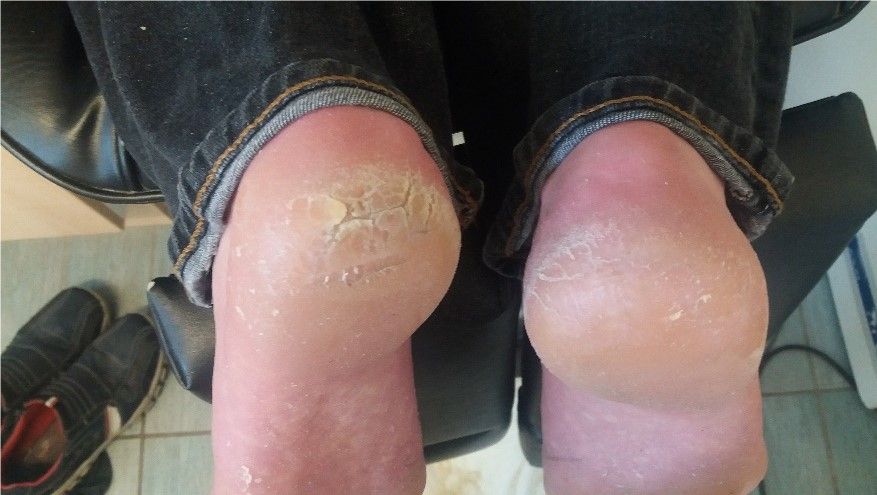
Foot Centre patient after treatment
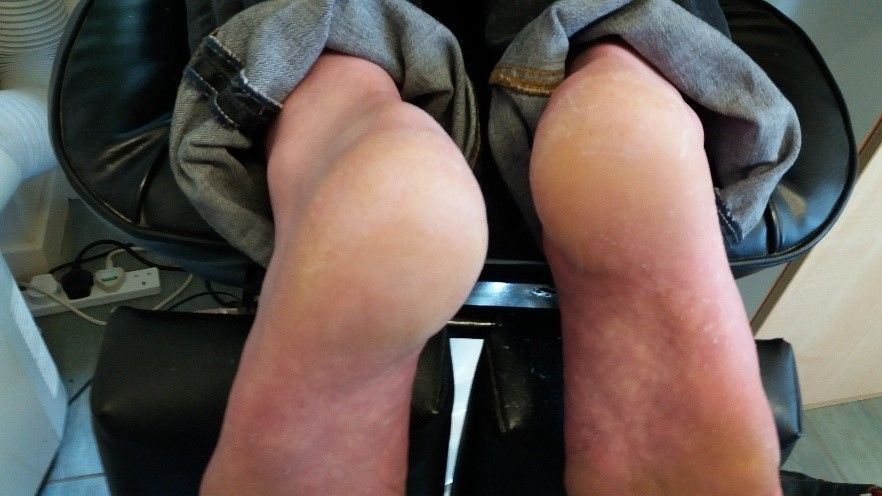
Chilblains
Chilblains (also called pernio) are small itchy, red (and sometimes purple) swellings on the skin, which can become increasingly painful, swell and dry out leaving cracks in the skin that expose the foot to the risk of infection. They occur on the toes (particularly the smaller ones), fingers, the face (especially the nose) and the lobes of the ears. They can also occur on areas of the feet exposed to pressure, for instance on a bunion or where the second toe is squeezed by tight shoes. They can also lead to blisters and break down to become a small ulcer prone to infection.
Who is most susceptible to developing chilblains?
Chilblains are caused by the skin's abnormal reaction to cold. They develop when the tiny blood vessels under the skin constrict under cold conditions reducing the flow of blood until the area warms up again and causes some leakage of fluid into the surrounding tissue. Not everyone develops them - it depends to a large extent on the efficiency of your circulation. People with poor circulation and other health problems involving their blood vessels are likely to be more prone to developing chilblains. In addition, damp or draughty conditions, dietary factors and hormonal imbalance can also be contributory factors. It is thought that rapid temperature changes from cold to hot can also be a cause: if the skin is chilled and is then followed by too rapid warming next to a fire or through using a hot water bottle, chilblains may result.
How can we help?
We can help by assessing the skin in the affected area looking for cracks or signs of infection. If appropriate, reducing any overlying callus or if the skin has broken or is ulcerated treating the area and applying a dressing
We will advise you as to how to prevent chilblains from recurring and also information as to home management
Athletes Foot
Athlete’s foot is a fungal infection of the skin that can lead to intense itching, cracked, blistered or peeling areas of skin, redness and scaling. It can occur on moist, waterlogged skin, usually between the fourth and fifth toes initially, or on dry, flaky skin around the heels or elsewhere on the foot. Large painful fissures can also develop and the condition can also spread along all five toes and sometimes to the soles of the feet if left untreated.
What causes it?
It is caused by a number of fungal species that you can pick up from someone else shedding infected skin, typically in communal areas such as pools, showers and changing rooms, or anywhere that you walk around barefoot. Athlete’s foot can also be passed on directly by person-to-person contact, although people who sweat more are more prone to infection.
Once your feet have been contaminated, the warm, dark and sweaty environment of feet in shoes or trainers provides the ideal breeding ground for the fungus. However, athlete’s foot also occurs in dry, flaky areas. It’s quite common in summer with sandal wearers. The sun makes your skin dry out so it loses its natural protective oils. This combined with the constant trauma from sandals makes your feet more prone to infection.
How can we help?
If left untreated, the fungus can spread to the toe nails, causing thickening and yellowing of the nail, which is much harder to treat. Fungal infections are highly contagious and can spread to anywhere on your skin, including your scalp, hands and even your groin. This is especially likely if you use the same towel for your feet as for the rest of your body.
Athlete’s foot is usually treatable at home, but we can help you by advising the best treatment for your particular type of athlete’s foot. And also (if the fungal infection has spread to your nails) by reducing the thickness and cutting back the nails thereby exposing the infected nail bed to a lighter, cooler environment.
Thick Nails
Thick toenails are a common complaint in podiatry in which thickening of the nail plate can cause discomfort, difficulty finding proper fitting footwear and in some cases ulceration under the nail plate.
What causes thick nails?
A nail can become thickened for many different reasons, including;
- Following an injury such as 'stubbing' it against something or dropping something on it
- Fungal nail infection
- Inappropriate or poorly fitting footwear
- Certain medical conditions or poor circulation
- Treatments such as chemotherapy
- Ageing
How can we help?
Thickened nails can cause pain and discomfort and are extremely difficult to self-treat. We can help by determining the cause of the thickening and undertake a careful trimming and filing down of the nail.
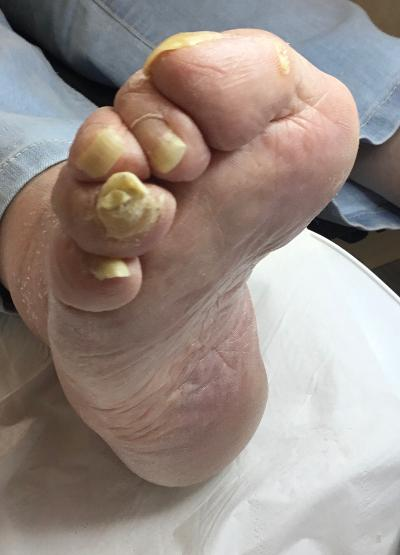
Fungal Nails
Here at the Foot Centre are able to conduct a painless in-clinic test to determine whether your discoloured or thickened nail is fungal or not. Previous laboratory testing of fungal nails could take 4-6 weeks for results to return. Today we are able to offer our patients a five-minute test which works by analysing a small sample of the affected nail using advanced molecular diagnostic techniques. It offers 97% accuracy with results unaffected by topical or oral anti-fungal treatments and it detects 99% of all common dermatophytes. By conducting the test here at the Foot Centre, it means there is no need to send a sample away and await results; advice and treatment can commence immediately.
How can we help?
There are a few different treatment options available for fungal nail infections. The treatment which may be recommended is based on an individual basis and is dependent on the severity of the infection along with other factors.
However, no treatment method for clearing fungal nail infections can offer a 100 % guarantee and it’s important that patients understand that it can take a long time for the infection to fully clear and in some cases, this can be up to 24 months. This is because this is how long it can take for an entire toenail to grow from root to tip. Its also important to know that unless changes are made to your foot health and hygiene there is a high recurrence rate for the infection. So, we always explain what you need to do to reduce this happening.
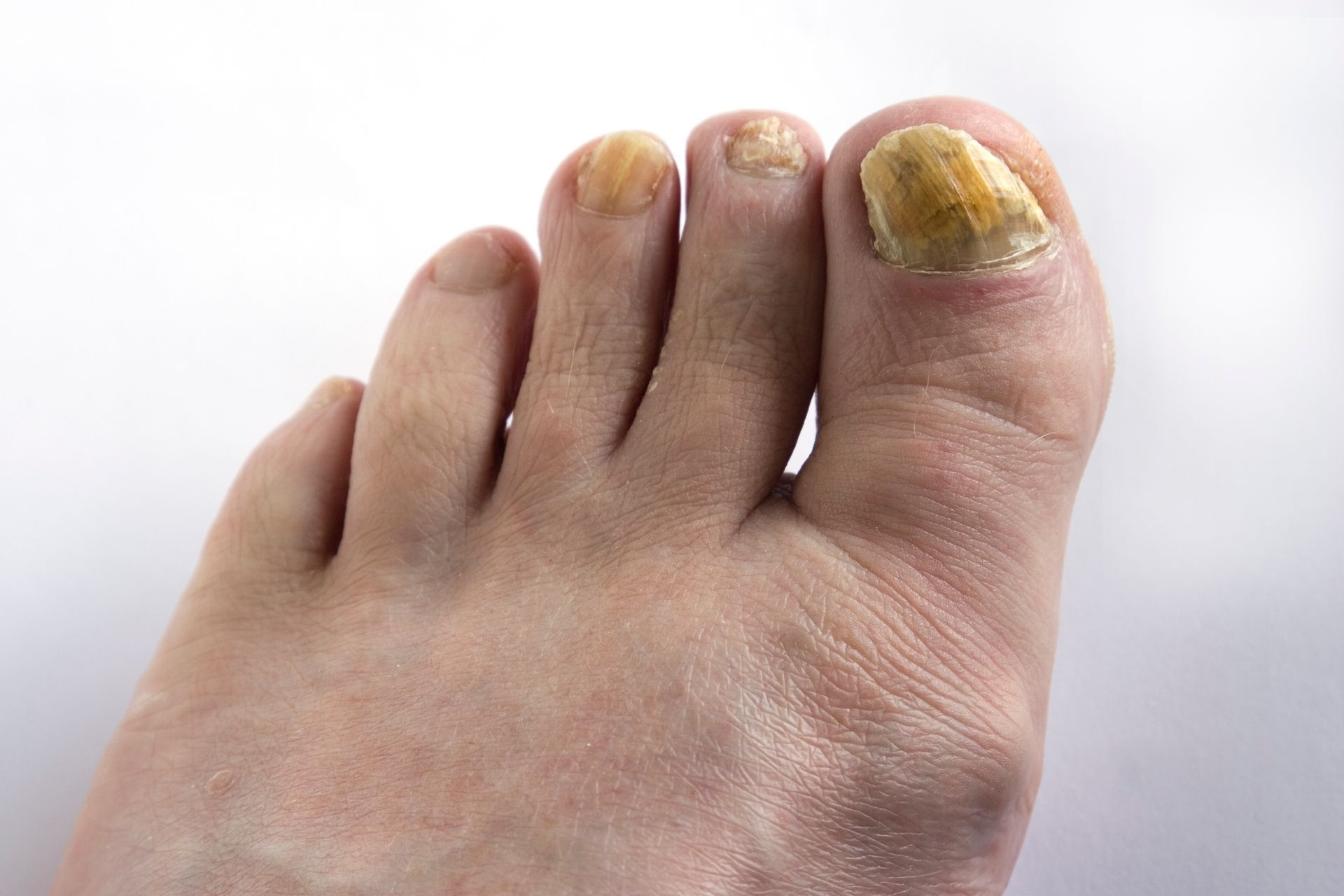
Treatment options include:
Oral Anti-Fungal Medication
Terbinafine and itraconazole are two fungal nail treatment methods that are both available in tablet form, meaning they can be delivered straight to the nail matrix through oral ingestion. However oral anti-fungal treatment also takes months and so involves taking a medicine daily for many months until the infection has cleared or recommended otherwise. As with all medications there can be risks and side effects and many patients prefer to avoid these.
Topical Anti-Fungal Treatments
Topical anti-fungal treatments can be applied at home by the patient until the infection has fully cleared. There are many different products advertised for the treatment of fungal nail infections, some which do not contain any anti-fungal properties at all. We will advise with regards to the most appropriate topical anti-fungal treatments to use at home. Topical anti-fungal treatments are best recommended for mild infections.
Toenail Fenestration
Here at the Foot Centre, we use the Lacuna Method of nail fenestration. This treatment may be recommended particularly if you would like to avoid taking oral medication and where the infection is such that it is unlikely to respond well to simple topical treatments.
This procedure is carried out without the need for anaesthetic. Toenail fenestration is a method where we drill micro-holes into the nail plate; this allows topical treatments to be able to penetrate the nail bed (the skin under the nail). If you choose this treatment option you need to apply a product at home until the infection has grown out, and return for re-drilling of the holes as recommended. An initial treatment plan consists of 4 appointments spaced out over a four-to-six-month period at intervals of 4 to 6 weeks.

Nail Surgery
One of the most direct treatment options is removing the nail entirely and destroying the nail matrix; this is done by using a local anaesthetic, removing the nail and then applying an acid to the root of the nail so it does not regrow. Destroying the nail matrix also stops the nail from growing back, preventing the risk of further infections. The alternative to removing the entire nail is temporary removal; upon doing this, we can apply a fungal nail treatment directly to the nail bed to treat the infection.
Verrucae
The signs and symptoms of verruca may include:
- Feeling like you are walking on a pebble
- Area of roughened skin (the skin may be spongy or scaly and may appear brown or grey)
- Tiny black dots may be visible;
- A verruca may appear alone or in a cluster.
What causes verrucae?
They are caused by a number of the Human Papilloma Viruses (HPV). There are various forms of HPV, which all relate to various parts of the human body but the HPV virus is thought to thrive in moist, damp environments such as swimming pools, changing room floors and communal shower areas.
Who gets a verruca?
Verrucae are common because anybody can catch a verruca; however some people are more susceptible than others, and these include:
- People who walk bare foot in communal areas
- People who live with someone who has a verruca
- Children and teenagers
- People who have a weakened immune system
If you have a verruca that is not painful, there is a good chance the body may kill the virus on its own; With children, most are resolved without any intervention within 2 years. If the verruca is not spreading and is not causing discomfort then there is a good argument for leaving it alone.
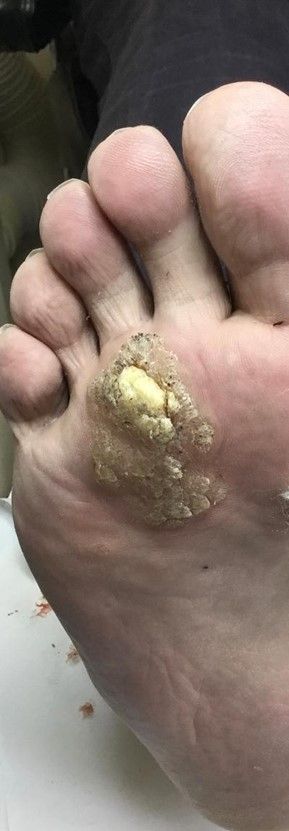
How can we help?
Where verrucae are painful, stubborn, unsightly and/or spreading, we can help. We can assess and advise you on the best approach for you with treatment dependent upon your age, the number of verrucae present, their location, size etc.
Please be aware no single verruca treatment option is 100% guaranteed to be successful and each one has pros and cons to be considered.
Treatment Options
Debridement: Where verrucae are painful or stubborn, we can help by undertaking the usually painless removal of the overlying surface of the verruca, although during this process the verruca may bleed debridement can help with any discomfort and may be considered sufficient treatment on its own.
Especially for children, debridement and/or occlusion (using zinc oxide tape at home) may be sufficient to help. The tape traps TEWLS (Trans Epidermal Water Loss) so that the verrucae soften and become painless. It can take months so patience is needed!
Acid based treatment: Another treatment is to use acid in a paste form to destroy the infected tissue; the type of acid treatment we use is stronger that over the counter treatments you might purchase from your local pharmacy and softens the skin and leads to a mild inflammation which by doing so stimulates the body to fight off the virus. It is a preferred approach by some because it is usually a relatively painless procedure, although there can be a little discomfort 2-3 days later when the acid starts to work
Cryotherapy:
This approach is using extreme cold temperatures to destroy the infected tissue by carefully applying liquid nitrogen or nitrous oxide. This is a traditional method that has commonly been used by GPs and Podiatrists but it can however feel quite uncomfortable. Once the area has been frozen a small scab or blister usually forms. It uses extreme cold therefore is an uncomfortable procedure, some discomfort can also be expected a few days after treatment.
Verrutop:
This is a relatively new method for treating verrucae which is popular due to being less invasive
(relatively low levels of discomfort) and highly effective. It is a topical solution (only used by health professionals) that contains Nitrizinc complex which we apply directly to the affected area after debridement. The nitri-zinc complex kills the wart tissue by breaking down its protein structure, leaving intact skin underneath. The number of Verrutop treatments required can vary depending on several factors, including the size, location and severity of the verrucae or wart. On average 3 treatments is sufficient but up to 6 treatments may be required, with an interval of 10-14 days between each treatment. The manufacturers of Verrutop state that following clinical trials 90% of patients were cured after a maximum of 6 treatments and 80% of patient saw clearance within 4 applications
Verruca Needling:
–This is good for treating stubborn verrucae by needling just one verruca. Compared to some other methods verruca needling usually requires fewer sessions (1-2) and shorter treatment durations. Most patients can expect to see positive results within a few weeks to a few months. However, this procedure is more invasive in that it requires the foot to be numbed using a local anaesthetic. Injections are given around your ankle or in your foot before using a small fine needle to cause controlled damage puncturing down through the epidermis and dermis; pushing the virus from the outer layer of skin (epidermis) into the deeper dermal layer of skin where it cannot survive






